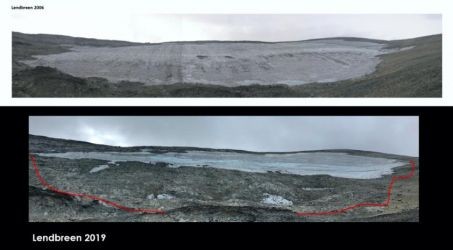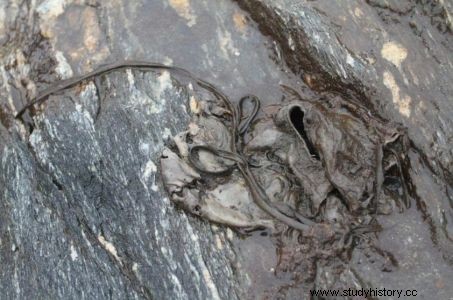In central Norway, global warming has caused the melting of ice sheets which, as they recede, have freed a multitude of vestiges preserved from the reindeer hunters of the Bronze Age to the Viking era. Exceptional discoveries.

Horse hoof snowshoe.
Here, a horseshoe; further on, a snowshoe for equines, remains of broken sleds, nails, walking sticks, bones of pack animals... and arrows still fletched. Little by little, a whole universe is resurfacing from the past under the eyes of Norwegian archaeologists for more than a decade now and whose inventory has just been made by the magazine Antiquity . More than a thousand objects have thus reappeared - and continue to do so - due to global warming which accentuates the melting of the ice and the retreat of the Lendbreen glacier, located between 1600 and 1900m above sea level, in the Lomseggen region. , Norway.
 Exploration of the Lendbreen ice sheet, Norway. ©Johan Wildhager/Palookaville/secretsoftheice.com
Exploration of the Lendbreen ice sheet, Norway. ©Johan Wildhager/Palookaville/secretsoftheice.com
All these discoveries tell the story of a high mountain pass and its frequentation over several centuries. Scientists have indeed uncovered the existence of an ancient circulation corridor used from the Nordic Iron Age, around 200-300 CE, until the Middle Ages. A communication route along which stone structures (cairns) served as landmarks for travelers moving through these icy immensities.
 Retreating Lendbreen Ice Patch. It is in these liberated spaces that the archaeological remains were discovered. Credits:Antiquity/secretsoftheice.com
Retreating Lendbreen Ice Patch. It is in these liberated spaces that the archaeological remains were discovered. Credits:Antiquity/secretsoftheice.com
Discoveries at altitude
Already in 2011, the team led by Lars Holger Pilo, from the glacier archeology program in Oppland, had collected, all wrinkled and shriveled, an extraordinary 3rd-4th century lambswool serge tunic from the glaciers at half Lomseggen fondues. The co-author of the article published in Antiquity had immediately brought this treasure, contemporary with the period of the Roman Empire, to the Norwegian Museum of Cultural History in Oslo, the capital, to be restored there (to be read in Sciences et Avenir n°795 ). Other finds then followed on the same glacier, including Viking-age leather mittens and shoes.
 11th century Viking shoe. Credits:secretsoftheice.com
11th century Viking shoe. Credits:secretsoftheice.com
Farmers and travelers of the past used this pass during seasonal transhumance, to pass from one valley to another. Loaded with dairy products and other cargo, they sometimes lost items on the way, when returning from summer pastures, or in the fall, when carrying fodder or reindeer hides. Forgotten amid these often-veiled expanses of mist, these objects eventually found themselves frozen in what became the Lendbreen Ice Sheet, where most of these organic materials were incredibly preserved.
 Distaff for spinning wool. Credits:Espen Finstad / secretsoftheice.com
Distaff for spinning wool. Credits:Espen Finstad / secretsoftheice.com
Among the finds listed, there are above all objects of daily life, like a knife with its handle, or a birch wood distaff intended for spinning wool, up to a ski of the age bronze (1750-500 BC) found in several pieces, an indication of the early presence of hunters in even earlier times. Remains moving by their simplicity which inform on the movements of exchanges which took place at the time in these regions. About sixty remains, subjected to radiocarbon dating, have made it possible to specify the periods during which this pass had been frequented, in particular around the year 1000, during the Viking period, when its frequentation peaked.
 Horseshoe found on the Lendbreen Ice Patch. Credits:Espen Finstad/secretsoftheice.com
Horseshoe found on the Lendbreen Ice Patch. Credits:Espen Finstad/secretsoftheice.com
A peak in activity linked to the increase in trade towards the fjords from the west, outlets for high-altitude rural products entering Norwegian Viking exports. Then, the number of visitors to this route continued to decline, until it was abandoned at the end of the Middle Ages, around the 14th century, when the Black Death which arrived around 1340 in this part of northern Europe led to a severe depopulation. Mountain archaeology, practiced for several years in the Alps, the countries of the North as well as in the Himalayas, provides new information on the forms of economic exchanges that these high altitude regions, far from be only the barriers or marginal areas that we thought.
